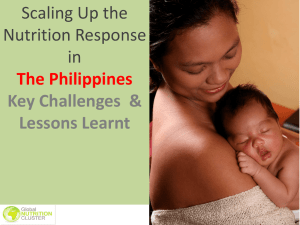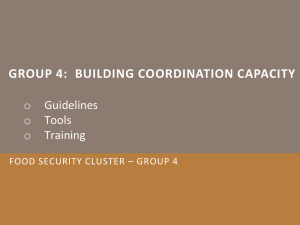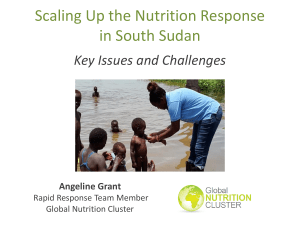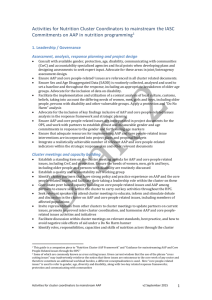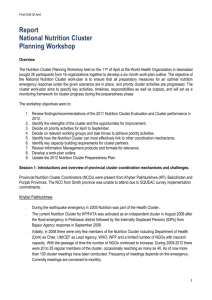CAR - Nutrition Cluster
advertisement
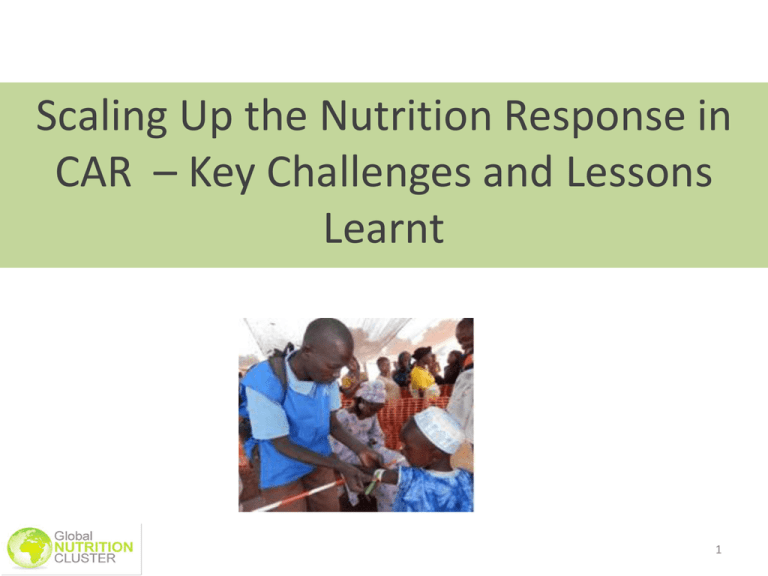
Scaling Up the Nutrition Response in CAR – Key Challenges and Lessons Learnt 1 Needs Assessment and Analysis 2 How were needs assessed in CAR as basis for response planning? • • • • • • MIRA was conducted in the five most affected prefectures (Ouham, Ouham Pende, Ombella Mpoko, Nana Mambere and Bangui) following the declaration of an interg-agency L3 to collect primary data. Secondary data were also reviewed to address and further inform the primary data collection. Participating agencies : 20 (NGOs+UN) – data collection was done from 23-30 Dec 13 Technical Support for surveys/assessments: Technical lead: WFP - IOM facilitators in the displacement sites in Bangui Planning for assessment and resources mobilizations for assessments: OCHA and partners Analysis workshop took place in Bangui in January 4 ; Drafting and revision of MIRA: January 4-5 ; Comments by the InterCluster: January 6; HC/HCT review and endorsement: January 7-10 SMART survey is being conducted in 16 prefectures – results are expected Mid-October. 3 Needs Assessment and Analysis- Challenges • For the nutrition cluster the MIRA data collected was of limited use • MIRA seemed to be heavy and appeared to be more useful for advocacy purpose rather than programming • The villages/quartiers surveyed do not constitute a representative sample of affected areas; • Sampling varied because of security; • Requires secondary data to provide overview; limited secondary data; • Key informant interviews were predominantly held with local authorities • SMART delays: recruitment of consultant, setting up of taskforce, access and security (multiple strategies put in place to mitigate), 2 coordinating gvt bodies • Fast-evolving situation needs change rapidly and central compilation of new needs/acute situations not well coordinated or disseminate (intersector level) Strategic Response Planning 5 How was nutrition cluster strategic planning developed in CAR? • Strategic plan was developed based on analysis on geographic priorities, gaps and updating needs assessment. SRP was adequately aligned with other programming – needs revision • The selection and prioritization of projects, and the review and endorsement of projects was done through selection committee put in place by the cluster • Target caseload determined, discussed and agreed by cluster members during a review meetings • 3/4Ws was done and continually updated to do gap analysis during cluster meeting - bilateral meeting with partner with regard to geographic coverage by prefectures and level of implementation of different activities – feedback were provided to partners, OCHA and donors. • Issue of “hotspots/enclaves inter-sector action plans for specific enclaves put in place 6 Response Planning-Issues and Challenges • Limited number of cluster partners for nutrition and low technical capacity of partners in CMAM • Lack of engagement from partners to take on MAM programming • Lack of government capacity and lower involvement • Heavy strategic planning process vs. extremely fast-evolving situation means strategic planning often takes too long/no longer up-to-date • Focus of response was initially in Bangui, lack of inter-sectoral strategy for outside Bangui now hubs established Resource mobilisation 8 Resources… 1.Finance 2.Supply 3.People Funding • • • • Major issues with funding during the first four months of L3 (only financed at 2%) Funding was captured through the prioritization of proposals for the CHF against the cluster strategic plan, and additional funds received from donors through OPS. The cluster advocate for gaps through effective communication during meeting with donors, HCT and others stakeholders, and developed advocacy notes Currently funded at 34% (Source: OCHA FTS) 10 Funding issues and challenges • Initially importance of nutrition was overlooked in CAR change in humanitarian leadership and increased advocacy means profile of nutrition has gone up • Most of partners are funded through UNICEF and WFP, which delayed nutrition cluster capacity to scale up due to administrative procedures of delayed fund release 11 Resource Mobilisation: SUPPLY 12 Supplies • Caseload calculations were used to identify quantity of nutrition supplies needed. • The cluster promoted information sharing around shelf life, storage conditions and facilitates the planning for preposition and delivery of supplies through regular cluster meetings and bilateral meetings with common suppliers. 13 Supplies challenges • Partners are reluctant to share on monthly basic the status of their stock. • Prepositioned stocks were challenged due to security 14 Resource Mobilisation: HUMAN RESOURCE CAPACITY Human Resources • Capacity mapping was conducted for scale up • Capacity gaps and training needs were identified and included in the SRP • On-job training was on partners personnel to build their capacity on IM 16 Human Resources-Challenges • High turn-over of staff in the field • Organisations with large scope yet limited human resources to implement adequately at large scale • Low human capacity of government 17 Implementation and Monitoring 18 Implementation and Monitoring • • • • • • Partners were engaged on the definition of objectives/activities/outcomes during the analysis of SRP. Indicators for monitoring were then identified from each outcome. A Nutrition Information Management System was put in place. An evaluation/Tracking matrix was developed. According to the protocol put in place, partners were requested to submit their statistical reports on monthly basic using a new reporting template. How was the progress in implementation by partners shared and communicated within the cluster and other stakeholders through bulletin, dashboard, Sitrep and cluster meetings. Situation monitoring was generally done by cluster member together with cluster coordination in the field with focus priority areas. Situation is regularly monitored and reported against plans with direct measurement of results. Regular meeting is held to present nutrition cluster data in nutrition cluster meetings with a focus on analysis and response. Any data collected are analysed and feedback to partners. Gaps in interventions were systematically identified through a regularly meeting with partners on the ground. Information collected was used to produce geographic mapping of CMAM services at prefecture and sub-prefecture level. 19 Cluster achievements As of end August 2014 137% BSFP beneficiaries *(6-59 months) MNP beneficiaries (6-59 months) 102% IYCF counselling (pregnant and children 023 months) 49% - 50,000 100,000 150,000 200,000 80% SAM admissions (6-59 months) MAM admissions (6-59 months) 42% - Achieved 1,000 2,000 3,000 4,000 5,000 6,000 7,000 Target 20 Implementation and MonitoringChallenges • Progress in gathering data and information for timely, regular reports and for decision- makers was often, due to inadequate knowledge and skills in data collection. • • Staff turnover, poor communication, problem of access, insecurity and transportation make data collection and management more expensive and time intensive. Incomplete and no reporting affected the nutrition performance monitoring. • QUALITY OF DATA • Delayed on implementation due to administrative delays of UNICEF and WFP in finalizing partnership agreements 21

